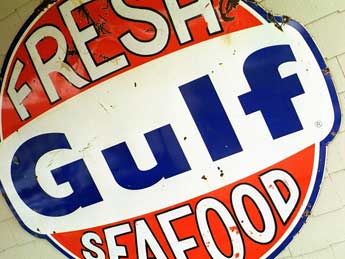
© unknown
An environmental law firm in New Orleans said it was preparing to challenge the government's public declaration that following the nation's worst-ever oil disaster, seafood from the Gulf of Mexico remained safe to eat.
Stuart H. Smith, Esq., of the law firm
Smith Stag, LLC., was leading the charge, rallying additional litigants to his side through a website called
Oil Spill Action.
He's the attorney who secured a verdict awarding over $1 billion over the radium contamination of leased land
due to oil drilling.
"Mr. Smith's litigation experience includes a lawsuit against Ashland Oil for contaminating the Lee aquifer, once one of the largest sources of fresh water for residents in eastern Kentucky," his self-published bio claims. "He also sued Chevron Corporation for damages associated with that company's contamination of the groundwater in the rural town of Brookhaven, Mississippi. His firm also represents clients injured by chemicals and defective drugs."
One of the toxicologists on Smith's litigation team pursuing BP was Dr. William Sawyer, who Raw Story
spoke with in November.
Even then, he was calling the Food and Drug Administration's safety test "little more than a farce."
"They did not test the [total petroleum hydrocarbons] (TPH) in their samples," he said, calling his testing methodologies a much more comprehensive way of examining compounds present in seafood when compared to the Food and Drug Administration (FDA) tests.
Dr. Sawyer added that some of his test samples came from seafood on its way to market, pulled from waters that had only recently been classified as safe for commercial fishing activities.
"The sensory test employed by the FDA detects compounds that are volatile that have an odor; we're detecting compounds that are low volatility and are very low odor," he added. "We found not only petroleum in the digestive tracts [of shrimp], but also in the edible portions of fish. We've collected shrimp, oysters and finned fish on their way to marketplace -- we tested a good number of seafood samples and in 100 percent we found petroleum."
The FDA says up to 100 parts-per-million (PPM) of oil and dispersant residue is safe to consume in finned fish, and 500-PPM is allowed for shellfish.
Adding up the claims"We are in the process of working up the damage claims on behalf of our clients and hoping to present those as soon as we can because the people need relief now," Smith told Raw Story on Tuesday.
"We represent everything from seafood retailers to shrimpers to crabbers to real estate developers," he said, noting that damages to be claimed will be "all over the place."
The claims were to target firms responsible for the oil spill, including BP, Transocean, Anadarko Petroleum, MOEX Offshore and Halliburton. Smith's clients included the United Commercial Fisherman's Association, among others.
"They want to see if they can get full recovery," Smith said. "Our job at this point is to build the damage claims, find out what it costs these businesses, what sort of environmental damages occurred and how much it'll cost to undo. Once we have all that, and we're pretty close, we'll sit down with them and see if we can get a deal. If not, we'll see them in court."
He added that his firm was "continuing to be retained by litigants with damage claims" related to the oil spill, and that observers could expect further litigation as cases develop.
Smith's efforts were noticed by MSNBC, which covered the gathering challenge to the government's declaration in a
Monday feature by reporter Kari Huus.
Huus, who also spoke to Dr. Sawyer, noted that the Natural Resources Defense Council (NRDC) shared his concern that the FDA's testing is inadequate. MSNBC similarly reached out to Dr. Susan Shaw, who Raw Story also spoke to in November.
Shaw, a marine toxicologist at the Marine Environmental Research Institute in Blue Hill, Maine -- who was not involved in Smith's litigation -- said that all the various components of crude oil "can damage every organ" in the human body.
"There is no safe level of exposure to this oil, because it contains carcinogens, mutagens that can damage DNA and cause cancer and other chronic health problems," she told Raw Story. "Many people in the Gulf have been exposed for months -- not just workers but residents. There are hundreds of health complaints from local people with symptoms that resemble symptoms of oil exposure. It will be years, possibly decades, before we understand the extent and nature of the health effects caused by this spill."
The initial effects of oil toxicity from ingestion include headaches, nausea, fatigue and rapid changes in mental state. It is unclear whether regular consumption of oil-tainted seafood would sicken a person, how quickly its symptoms would begin to show, or in what ways they would manifest.
Scientists with the US Geological Survey and US Department of Energy estimate BP spilled at or near 4.9 million barrels -- or approximately 666,400 metric tons of crude -- making BP's 2010 Gulf spill the worst accidental release of oil in human history.
Reader Comments
to our Newsletter